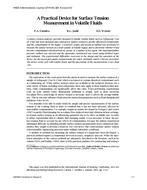Stack or buoyancy forces due to the difference in density between cold outdoor air and warm indoor air are known to be a source of problems in tall buildings in cold climates. The best known example is high pressure differences causing entrance and stairwell doors to require excessive force to open or close. Other problems are due to the airflow induced by stack forces through the building envelope and interior zones. A common example is excessive infiltration of cold air through the building envelope on lower floors, causing excessive heating load and discomfort to building occupants.
Stack effect occurs in reverse in hot climates, where outdoor air is less dense than cool indoor air. However, the pressure difference is usually much smaller in hot climates because the temperature difference is smaller; thus the problems induced are not as noticeable. This study concentrates on the cold outdoor situation, which can produce peak stack forces twice as large as the hot outdoor situation.
Product Details
- Published:
- 1993
- Number of Pages:
- 242
- File Size:
- 1 file , 5.8 MB
- Product Code(s):
- D-RP-661


